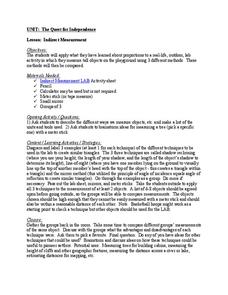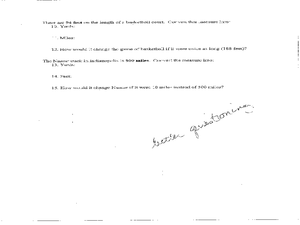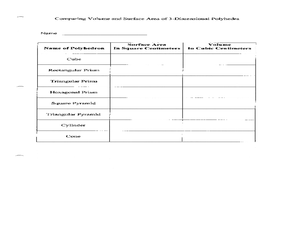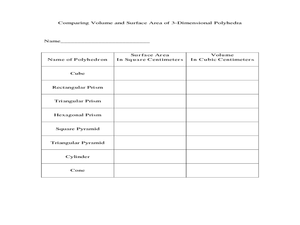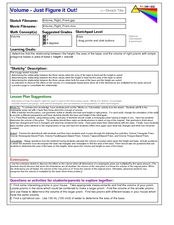Curated OER
Indirect Measurement
Young scholars measure and apply their knowledge of proportion to solve problems. For this geometry lesson, students measure using a meter stick, small mirror and measuring tape. They compare and contrast their measurements to objects...
Curated OER
Measuring the Egyptian Way using the Pythagorean Theorem
Students measure using the Pythagorean Theorem. In this geometry lesson, students solve right triangles using the properties of the Pythagorean theorem. They apply the same knowledge to solving story problems.
Curated OER
Measurements in Sports
Sixth graders study measurement problems. In this geometry lesson, 6th graders discuss the different types of measurement used in sports and answer questions regarding measurement problems in sports.
Curated OER
Perimeter Word Problems
Tenth graders solve for the perimeter and rewrite word problems. In this geometry lesson plan, 10th graders label different shapes and set up the corresponding ratios as equations. They solve for the missing side and calculate the values...
Curated OER
Perimeter and harder equation practice
Students calculate the perimeter of different shapes. In this geometry lesson, students set up the relationship of the perimeter using equations. They set up the proper ratio and solve using the distributive property. They relate...
Curated OER
Coordinate Plane
Tenth graders draw, label, plot and locate points on a coordinate plane. In this geometry instructional activity, 10th graders define a coordinate plane and identify the different quadrants. They relate coordinate plane to the game of...
Curated OER
Solid Surface Area
Students calculate the area of solids. In this geometry lesson, students use formulas to find the surface are and the volume of solids. They investigate 3-dimensional shapes.
Curated OER
The Value of Volume
Students measure the perimeter and area of their polygons. In this geometry lesson, students calculate the volume and area using the correct tools. They calculate the time and temperature and the perimeter and side lengths of triangles.
Curated OER
Introduction to Polyhedra
Students investigate Euler's Formula. In this geometry lesson, students perform an inductive activity of Euler's Formula using nets to identify a variety of prism, pyramids, cylinders, and cones.
Curated OER
Volume of Prisms
Students calculate the volume of different polygons. In this geometry lesson plan, students identify the relationship between base and height. They calculate the area of each prism and cylinder.
Curated OER
Mass Measurement
Middle schoolers explore geometry by completing a physics activity on-line. In this mass measurement lesson, pupils define the terms mass, volume, and density and identify their relationship with each other. They complete an on-line...
EngageNY
Properties of Parallelograms
Everyone knows that opposite sides of a parallelogram are congruent, but can you prove it? Challenge pupils to use triangle congruence to prove properties of quadrilaterals. Learners complete formal two-column proofs before moving on to...
EngageNY
The Volume of Prisms and Cylinders and Cavalieri’s Principle
Young mathematicians examine area of different figures with the same cross-sectional lengths and work up to volumes of 3D figures with the same cross-sectional areas. The instruction and the exercises stress that the two...
EngageNY
Points of Concurrencies
You say that perpendicular bisectors intersect at a point? I concur! Learners investigate points of concurrencies, specifically, circumcenters and incenters, by constructing perpendicular and angle bisectors of various triangles.
EngageNY
Translations
Learn through constructions! Learners examine a translation using constructions and define the translation using a vector. Pupils then construct parallel lines to determine the location of a translated image and use the vector as a guide.
EngageNY
Making Scale Drawings Using the Parallel Method
How many ways can you create a dilation? Many! Individuals strengthen their understanding of dilations by using various methods to create them. The new technique builds on pupils' understanding of the ratio method. Using the ratio,...
Other popular searches
- Math Art Geometry Lessons
- Math Geometry Lessons
- Esl Lessons Math Geometry
- Esol Lessons Math Geometry
- Mummy Math Geometry Lesson
- Math Geometry Lesson Plans


